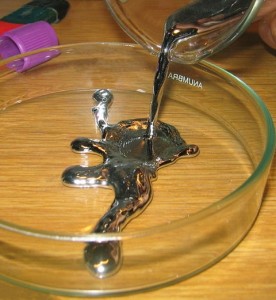By Doug Struck
Globe Correspondent
The first documented victim was a little girl, just shy of six. Bright and active, she suddenly had troubles walking. Her words spilled out, uncontrolled and disordered. Her body whipped about in convulsions. A few days later, her sister developed the same symptoms.
Soon others in the small Japanese town of Minamata were stumbling, jerking, careening, in the same strange way that the cats in town had been known to fall into the sea: “cat suicide,” the residents had called it.
Those cases in 1956 blossomed into one of the world’s most shameful environmental scandals. They, and eventually more than 2,200 others, were poisoned by the mercury pumped into the local bay by a plastics factory. The mercury accumulated in fish, then in the people (and cats) that ate the fish.
The company and the government in Japan denied the cause for years. Scientists now know the heavy metal accumulates in the body, sends the central nervous system into seizures and convulsions, impairs the brain, and eventually killsWe have grown more suspicious of our food. But as our technological and industrial age has produced more toxins, and as we have turned more to the sea for food, sinister traces of mercury remain in our diet.
The Environmental Protection Agency last week provided some good news. Anepidemiological study found blood mercury levels of women of childbearing age have dropped 34 percent over the last decade in this country. Those women, the report said, appear to be choosing to eat fish lower in mercury, such as salmon, pollock, catfish, shrimp, and canned light tuna.
Some advocates concerned about mercury are blinking at the report. They note that the amount of fish consumed in this country has not decreased, nor do they believe the amount of mercury in ocean fish is dropping.
“They looked at the blood mercury levels from the Center for Disease Control. They saw the downward trend, and they hypothesized that it shows these women are making a more informed choice,” said Michael Bender, who runs the Mercury Policy Project/ Zero Mercury Working Group, a nonprofit based in Montpelier, Vt. “The hypothesis is reasonable. But it’s only a hypothesis.”
If it is right, it is a demonstration of the power of information and education, said Elizabeth Saunders, Massachusetts director of Clean Water Action, which also has long worked on the issue of seafood safety.
“It shows those advisories are working,” she said, referring to government warnings about fish with high mercury levels. But the fundamental problem is in the toxicity of the fish. “It would be great if women did not have to make choices about what fish they eat.”
In 2004, the EPA advised consumers — especially children and women who could become pregnant — to end their consumption of swordfish, shark, king mackerel, and tilefish, and to reduce the frequency of eating tuna steaks, canned albacore tuna, and tuna sushi.
The advisories are old, and the federal government is working on updating the list. In addition, Bender noted, scientists have regularly reduced the amount of mercury that should be considered safe in our diet. “The exposure risks are much greater than we thought,” he said.
While some mercury is naturally occurring, much of it is a product of our industrial age. As coal-fired electric plants and incinerators — major sources of mercury in the air, which is then absorbed in the water — have closed, Massachusetts authorities believe they are seeing a reduction in the mercury in freshwater fish in the commonwealth, said Ed Coletta, a spokesman for the Massachusetts Department of Environmental Protection.
But if there are some signs of improvement in the United States, that is not reflected worldwide, according to a report earlier this year by IPEN, a network of toxics experts, and the Biodiversity Research Institute, a non-profit based in Gorham, Maine. The report found mercury contamination of fresh and ocean waters globally, fish samples with mercury that regularly exceeded health standards, and unsafe mercury levels in 82 percent of human hair samples from eight countries.
Earlier this month, the United States agreed to what is called the Minamata Convention,an international pact to reduce mercury. Delegates from more than 140 countries adopted the convention in January, calling for limits on emissions and curbs on some mercury products. The pact will take force when 50 countries sign it.